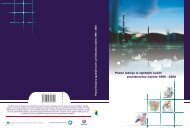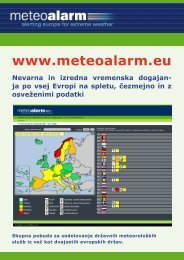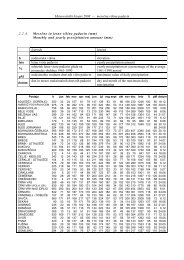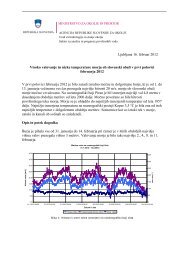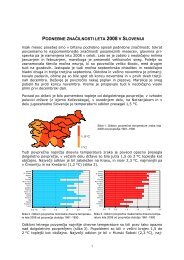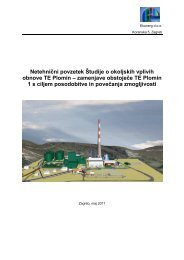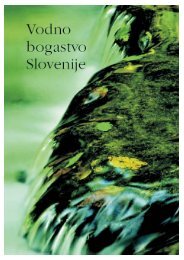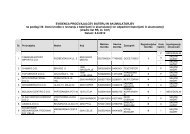Water Quality in Slovenia - Agencija RS za okolje
Water Quality in Slovenia - Agencija RS za okolje
Water Quality in Slovenia - Agencija RS za okolje
Create successful ePaper yourself
Turn your PDF publications into a flip-book with our unique Google optimized e-Paper software.
3 Groundwater<br />
3.1<br />
Aquifers and Groundwater Bodies<br />
Surface waters and groundwater differ from one another <strong>in</strong> many aspects. We are often fasc<strong>in</strong>ated by<br />
the unique beauty of <strong>Slovenia</strong>n rivers and lakes. But it is not so easy to appreciate the richness and<br />
beauty of the waters beneath the Earth’s surface. Groundwater is a valuable source mostly hidden<br />
from our eyes, often we do not even know where it is to be found. It occurs with<strong>in</strong> ground and rock<br />
pores and fissures, and we can admire it at its spr<strong>in</strong>gs or <strong>in</strong> our karst caves.<br />
The importance of groundwater becomes apparent at the fact that groundwater is the source of<br />
dr<strong>in</strong>k<strong>in</strong>g water for approximately 97% of the <strong>in</strong>habitants of <strong>Slovenia</strong>. Groundwater quality of many<br />
aquifers complies with all the requirements for dr<strong>in</strong>k<strong>in</strong>g water. We can therefore consume it <strong>in</strong> its<br />
natural state. This is a very important advantage of <strong>Slovenia</strong>, be<strong>in</strong>g rare <strong>in</strong> both the European region<br />
and elsewhere <strong>in</strong> the world. In addition, groundwater is an important source of <strong>in</strong>dustrial water, and<br />
is also used for the irrigation of agricultural land.<br />
The pollution transferred from the pollution source <strong>in</strong>to the aquifer is reta<strong>in</strong>ed there for a longer<br />
period due to slower current, as well as chemical and physical processes between pollutant and<br />
humic substances or m<strong>in</strong>eral particles. The natural purification of groundwater <strong>in</strong> aquifers is a longlast<strong>in</strong>g<br />
process. The artificial purification of groundwater is an expensive technological procedure<br />
of very limited effectiveness. The most important task of each <strong>in</strong>dividual and every <strong>in</strong>stitution is to<br />
prevent any pollution of groundwater sources.<br />
In sediments and rocks, voids of different sizes appear. The sediments’ and rocks’ characteristic of<br />
conta<strong>in</strong><strong>in</strong>g voids is called porosity. Permeability is aquifer’s ability to conduct water. Rocks of good<br />
permeability are highly abundant.<br />
Groundwater is thus stored <strong>in</strong> moderately to highly permeable sediments and rocks called aquifers.<br />
They can be situated near the surface or hundreds of meters beneath it.<br />
The term aquifer is derived from the Lat<strong>in</strong> words aqua (water) and ferre (to carry). An aquifer can be,<br />
for example, a layer of gravel, sand, conglomerate, sandstone or a layer of fractured limestone and<br />
dolomite.<br />
The largest part of the <strong>Slovenia</strong>n territory is composed by sedimentary rocks of relatively high porosity<br />
- i.e., <strong>in</strong>tergranular (19%), fissure (14.2%) and karst-fissure porosity (33.2%). The rest of <strong>Slovenia</strong> (32.8%)<br />
is built by rocks of lower porosity and <strong>in</strong> this way of smaller abundance (64), (Map 11).<br />
In <strong>Slovenia</strong>, we thus make a dist<strong>in</strong>ction between aquifers with <strong>in</strong>tergranular, karst and fissure<br />
porosity.<br />
Aquifers with <strong>in</strong>tergranular porosity, also called alluvial aquifers, are from the Tertiary and Quaternary<br />
age. Our larger rivers have deposited layers of flatland gravel and sand <strong>in</strong>to tectonic depressions.<br />
They are found <strong>in</strong> the central, eastern and north-eastern parts of <strong>Slovenia</strong>. Such flatland regions are,<br />
for example, <strong>in</strong> the valleys of the rivers Sava, Sav<strong>in</strong>ja, Krka, Mura and Drava.<br />
Aquifers with karst and fissure porosity are are built by carbonate rocks, mostly limestone and<br />
dolomite from the Mesozoic and Palaeozoic ages. They can mostly be found <strong>in</strong> the northern, northwestern,<br />
western and southern parts of <strong>Slovenia</strong>. These are the mounta<strong>in</strong>ous karst regions of the<br />
53




